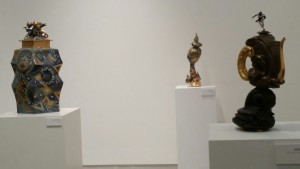
Clay Exhibit To Brings Renowned Artists to Orange Coast College
Orange Coast College: Frank M. Doyle Art Pavilion (access from Merrimac Way), 2701 Fairview Rd., Costa Mesa, CA. 92626
OCC is set to host its second Pedagogic Clay 2 Exhibit, opening on Jan. 28 and running thought Feb. 26, 2015. The month-long exhibition features work from 60 ceramic artists and instructors in the Southern California area ( Los Angeles, Orange, and Riverside counties). There are notable works by Ralph Baccera, Adrian Saxe, Peter Shire, Phyllis Green, Joe Soldate, Gifford Myers, Nobo Nishigawara, David Kiddie, Laura Haight, among others. OCC ceramics professor Kevin A. Myers has curated the exhibit. The exhibition is free and open to the public.
Individual works of art will be displayed in the Frank M. Doyle Art Pavilion. Gallery hours are; Mon, Tues, Thurs 12noon-6pm and Wed. 12noon-8pm. There is paid visitor and metered parking near lot D. Anyone with an interest in ceramics is encouraged to attend. “This is a time when all of this is going to be under one roof and it really would be in a student’s best interest to see the trajectory that contemporary ceramics has taken,” said Myers. “The artists that have been invited to be in this exhibition are truly exceptional.”
FOOD FOR THOUGHT
(artist's statement: "Vegetable Series")
This series of work is the result of my fascination with the whimsical qualities of vegetable forms. I am not interested in merely creating the exact likeness of vegetables, but rather in appropriating their unique shapes and qualities as a springboard for creating functional art objects.
The idea is not new. Cave men found gourd forms useful for containing food and drink. And why not, when these shapes are Nature's own way of providing containers for seed and food to perpetuate itself.
The particular vegetables used in the series were found by haunting local grocery stores, wholesale markets, and various gardens, patches, and fields. Each shape was chosen for its unique whimsical quality and presence. Original molds were made from the actual vegetables and the resulting shapes used to produce the individual pieces.
I feel that the challenge of the Artist is to take the common and mundane and, thru creative vision and process, breath new life into them. I hope that exposure to this work prompts a more sensitive look at the world around us. Such things as vegetables are not just for food, but food for thought, use, and enjoyment.